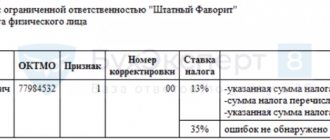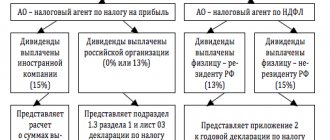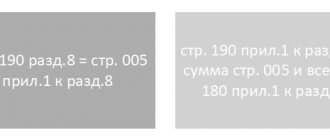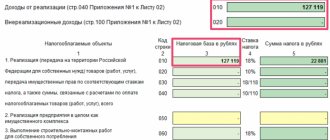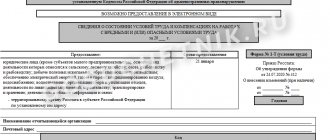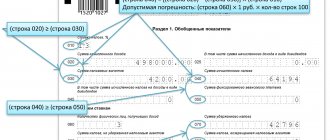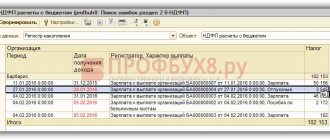- home
- Reference
- Insurance premiums
All reports generated by entrepreneurs and companies have control ratios. Therefore, values specified in one document must be consistent with information in other documentation.
No deviations or higher or lower amounts are allowed. 6-NDFL also belongs to these forms, so it correlates with other papers, for example, with 2-NDFL and DAM. Tax inspectors are involved in comparing indicators, so when discrepancies are identified, problems arise with representatives of the Federal Tax Service. Entrepreneurs themselves must do the reconciliation to avoid discrepancies.
The concept of control ratios 6 personal income tax and calculation of insurance premiums
They are very easy to find and identify, since the necessary information is contained in letters of the Federal Tax Service No. BS-4-11/ [email protected] and No. BS-4-11/4371. It also provides information on what measures are used by tax inspectors to identify discrepancies.
The first letter indicates the control relationships existing between Form 6-NDFL and insurance premiums.
The basic rules that businessmen must adhere to include:
- is certainly transferred to the employees of the Federal Tax Service of the RSV when submitting 6-NDFL, but the ratio applies only to parent organizations;
- when calculating indicators in 6-NDFL, total income excluding dividends must be equal to or greater than the base used to determine insurance premiums for pension insurance.
Attention! The last ratio does not apply to taxpayers who do not have separate divisions, and also does not apply to individual entrepreneurs working under UTII or PSN.
Since 2021, new inter-document relationships regarding the 6-NDFL form have been in force, which is recorded in the letter of the Federal Tax Service N BS-4-11 / [email protected] Based on this document, one important relationship must be observed between the DAM and 6-NDFL. The total amount of income excluding dividends must be equal to or greater than payments calculated in favor of citizens. This rule applies in each reporting period entirely to the tax agent, so all divisions and branches are taken into account.
If for various reasons this condition is not met, then this becomes the basis for initiating an unscheduled tax audit, as suspicions arise about understatement of income.
It is also useful to read: Details for paying insurance premiums for individual entrepreneurs
Is it possible to do calculations online?
For reconciliation, entrepreneurs and their employees can use special online calculators. With their help, insurance premiums, personal income tax and other indicators are calculated. Thanks to the data obtained, it is possible to detect discrepancies or errors in the company's accounting department.
For the calculation, enter the following data:
- salary paid to employees monthly;
- the period during which the organization operates;
- personal income tax rates, since sometimes foreigners are employed and pay 30% of income;
- A 9% rate applies to dividends.
Using an online calculator, entrepreneurs receive information about the monthly tax burden. Some sites offer more detailed information, so you can find out not only the amount of personal income tax, but also the insurance premiums that must be paid for all employees of the organization. After such a calculation, a reconciliation is easily carried out, which allows you to make sure that the information in the DAM and 6-NDFL is the same.
How will this affect reporting?
At the beginning of January, the developers of Kontur.Externa added a check for control ratios in the DAM. But a lot of complaints began to come from users: the check was triggered in cases where the employee worked for a fraction of the salary. The check was turned off and after the letter dated January 17 was released, they did not turn it on again, because the situation would have repeated itself.
This means that when sending DAM and 6-NDFL, the program will not show that the amount of payments is below the minimum wage or the average for the constituent entity of the Russian Federation. If the control ratios are not met, the Federal Tax Service will accept the report, but then, as part of a desk audit, will send the company a request for clarification, which will need to be responded to within 5 days.
To prepare for such a development, you can check whether your control ratios are met before sending the report. The minimum wage is known, and the average salary by industry and subject of the federation can be determined using a calculator for calculating the tax burden on the Federal Tax Service website. So far there is data only for 2018 and for OSNO, but they allow you to at least roughly understand whether you should expect requirements.
To see average salary data, select 2021 as the tax period, find your type of activity and subject of the Russian Federation in the drop-down list:
On the page that opens below there will be industry average salary data in the region:
If you find that your payments are below the minimum wage and the average for a constituent entity of the Russian Federation, be prepared to explain the situation to tax officials.
How to verify data
Entrepreneurs carry out reconciliation themselves, and can also entrust this procedure to an accountant or third-party auditor. The procedure is carried out before the reports are transferred to the Federal Tax Service, which makes it possible to ensure that there are no discrepancies.
Important! When submitting 6-NDFL reports, you must immediately submit calculations for insurance premiums, which simplifies the verification process for tax inspectors.
If it turns out that the accrued income is less than the payments and rewards transferred to individuals, then this is represented by a violation of the control ratios. Therefore, the entrepreneur did not include any payments to individuals in the personal income tax tax base. Such a discrepancy requires special testing to identify the cause of the error.
It is possible not to carry out control ratios if the company paid daily allowances to employees. But under such conditions, it is necessary to provide special explanations to the tax inspectors. In this case, the calculation of contributions for 6 months of work is submitted by July 30, and the report on 6-NDFL by July 31. Discrepancies do not always indicate the presence of an error, but they require clarification from employers.
In April 2021, a review of reports received from businessmen for a year of work began. The forms are subject to verification by tax inspectors. Therefore, within a month, entrepreneurs receive letters from representatives of the Federal Tax Service when errors are discovered.
According to standard control ratios, income from which personal income tax is withheld must be less than all payments transferred to employees. If the organization has separate divisions, then this rule does not apply, since the income will not converge. Therefore, representatives of the Federal Tax Service check line 030 of subsection 1.1 of section 1 of the RSV with line 020 of section 1 of 6-NDFL.
New control ratios for DAM
The innovations affected the previously existing ratios, also by letter of the Federal Tax Service No. BS-4-11 / [email protected] dated May 29, 2020. new types of values were introduced: internal and interdocument .
Interdocument control ratios
The new CS are designed to verify the compliance of the application of the feed-in tariff. With their help, regulatory authorities determine whether the taxpayer is a small business.
, KS 2.8-2.10 were introduced . code 20 in the calculation of insurance premiums , then at the beginning of each month, if there are accruals in columns 2, 3, 4 in subsection 1.1 of Appendix 1 of Section 1, the company must be in the SME register. Otherwise, the application of the reduced tariff will be unjustified.
There are situations when a taxpayer is excluded from the register in the middle of the last month of the quarter. In this case, the company has the right to apply a reduced tariff, since at the beginning of the month in question it was on the register.
Before filing a DAM with code 20 , it is recommended to check the status of a small enterprise. If a discrepancy is detected, the Federal Tax Service will require you to explain the reason for applying the preferential rate, after which you will have to make corrections and submit an updated calculation.
Internal control ratios
To check the correctness of filling out the calculation of insurance premiums of the Federal Tax Service, internal control ratios were introduced.
New reference ratios:
- 1.193 - there is no appendix 1 of section 1 SV with the value 01 in field 001 when there is appendix 1 of section 1 SV with the value 20 in field 001
- 1.194 - there is no subsection 3.2.1 of section 3 SV for the FL with a value in field 130 = NR if subsection 3.2.1 of section 3 SV for this FL is present with a value in field 130 = MS
- 1.195 - there is no subsection 3.2.1 of section 3 of the SV for the FL with a value in field 130 = VZHNR in the presence of subsection 3.2.1 of section 3 of the SV for this FL with a value in the field 130 = VZHMS
- 1.196 - there is no subsection 3.2.1 of section 3 of the SV for the FL with a value in field 130 = VPNR in the presence of subsection 3.2.1 of section 3 of the SV for this FL with a value in the field 130 = VPMS
- 1.197 - line 150 for each value of field 120 of subsection 3.2.1 of section 3 SV with a value in field 130 = NR < minimum wage in the presence of subsection 3.2.1 of section 3 SV for a given FL with a value in field 130 = MS
- 1.198 - line 150 for each value of field 120 of subsection 3.2.1 of section 3 SV with a value in field 130 = VZHNR < minimum wage in the presence of subsection 3.2.1 of section 3 SV for this FL with a value in field 130 = VZHM
- 1.199 - line 150 for each value of field 120 of subsection 3.2.1 of section 3 of the SV with a value in field 130 = VPNR < minimum wage in the presence of subsection 3.2.1 of section 3 of the SV for this FL with a value in field 130 = VPMS
Ratio 1.193 when the policyholder applies a reduced tariff determines the procedure for filling out Appendix 1, Section 1. The sequence of making charges will be as follows:
- the code 01 must be entered . The amounts of wage accruals must be within the minimum wage
- in the second Appendix 1, code 20 and charges are made that exceed the minimum wage
The ratios of group 1.197-1.199 are considered the most important for taxpayers . In addition, the list includes codes for the category of individuals. For example, MS are individuals who receive preferential accruals in excess of the minimum wage. If there is such a code, the HP code must be entered in field 130 in subsection 3.2.1 of section 3.
Using the example of the control ratio 1.197, the verification of accrued amounts in the DAM will be carried out as follows:
- if the MS code is present in subsection 3.2.1, then the base for calculating contributions should be equal to the minimum wage. If the tax base is less than 12,130 rubles, then the MS code cannot be used
- if the base is below the minimum wage and there are accruals at reduced rates, then in this case the calculation will have to be adjusted
What to do if there are discrepancies
If, during an independent check, an entrepreneur discovers inaccuracies, then along with the reports, explanations are sent to representatives of the Federal Tax Service. There are no discrepancies if employees received only wages and no other remuneration. The indicators will not converge if there are additional payments on which personal income tax is paid, but insurance premiums are not transferred.
When drawing up an explanatory note, the exact and documented reason is indicated. For example, companies often use a GPC agreement when collaborating with individuals. Payments under this agreement are subject to personal income tax, but insurance premiums are not paid from them.
Another example is severance pay, child care or maternity benefits. Personal income tax is not paid from them, so they are not indicated in 6-NDFL, but such transfers are entered into the RSV.
Due to such payments, discrepancies appear, so it is advisable to immediately draw up an explanatory note, which is attached to the reports submitted to the employees of the Federal Tax Service. But the total indicators in 6-NDFL must always be greater than or equal to the values from the DAM. Tax inspectors are confident that income subject to personal income tax should be greater than the amount from which only insurance premiums are withheld.
Reference! If the entrepreneur does not send explanations on his own, then they are requested by the inspectors after the reconciliation. To do this, the businessman receives an official letter at his registration address.
He can obtain such information through his personal account on the Federal Tax Service website. After this, explanations are given in due time. In their absence, representatives of the Federal Tax Service can hold the taxpayer accountable and assess additional tax.
The reasons for the discrepancies can be found in the video:
It is also useful to read: Additional tariffs for insurance contributions to the Pension Fund
Personnel accounting and payroll calculation in 1C 8.3 ZUP 3.1
Hello, dear zup1c subscribers!
Qualified payroll specialists know that the income that we show in Section 1 of 6-NDFL may be less than the income that is shown in line 030 of Appendix 1 to Section 1 of the RSV ; this is a normal and understandable situation. I am sure that you are one of them.
Nevertheless, at the beginning of this year, a letter from the Federal Tax Service was issued (dated March 20, 2019 No. BS-4-11 / [email protected] ), in which the tax authorities added a new control ratio, just for checking these indicators. According to it, income in 6-NDFL must be GREATER OR EQUAL to income in the RSV . Although this is NOT always the case.
Income in 6-NDFL may be less, for example, parental leave is not shown in 6-NDFL, but is shown in income in RSV. There are a number of other reasons. With an error in this control ratio, we must submit a report , but our task is to explain to the tax authorities what this difference came from when they send us a request for clarification. So in today’s material I will tell you how to quickly explain the discrepancies between 6-NDFL and RSV in income information , using standard 1C ZUP 3 reports.
By the way, I highly recommend the SEMINAR on the preparation of quarterly reporting (6-NDFL, ERSV). If you want to quickly update your knowledge on the issue of preparing salary reporting in 1C programs, as well as find out all the changes in legislation and in the 1C zup 3 program regarding regulated reporting, then watch the recording of this seminar. I described in detail how to get FREE access to the recording here:⏩ zup1c.ru/kvartal-seminar/
Well, today we’ll talk about explaining the difference between income in 6-NDFL and DAM:
✅ Seminar “Lifehacks for 1C ZUP 3.1”
Analysis of 15 life hacks for accounting in 1C ZUP 3.1: Find out more ->>
✅ CHECKLIST for checking payroll calculations in 1C ZUP 3.1
VIDEO - monthly self-check of accounting: Find out more ->>
✅ Payroll calculation in 1C ZUP 3.1
Step-by-step instructions for beginners: Find out more ->>
✅ All free seminars on 1C ZUP 3 ->>
I described in detail how to get FREE access to the recording of the quarterly seminar on reporting preparation (6-NDFL, ERSV) here: ⏩ zup1c.ru/kvartal-seminar/
Consulting with a discount using PROMO CODE - on this page you can read about me and my services, as well as leave a request for a consultation with a discount (promotional code for receiving the “I Want Knowledge” discount).
Setting up the report “Analysis of contributions to funds - by month of receipt and registration of income” can be downloaded here: https://yadi.sk/d/x99KJKfLuQv6PQ
To be the first to know about new publications, subscribe to my blog updates:
or join groups on social networks, where all materials are also regularly published:
- in contact with;
- YouTube channel;
- classmates.
- facebook;
Best regards, Dmitry Gerasimov!
If you liked the publication, you can save a link to it on your page on social networks. To do this, use the “Share” located just below.
